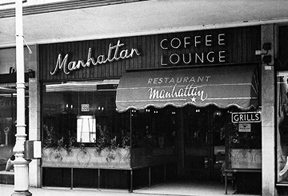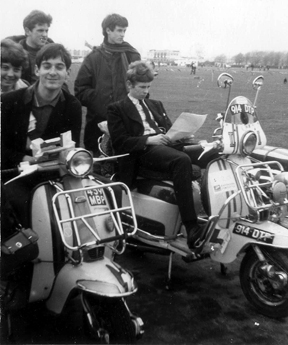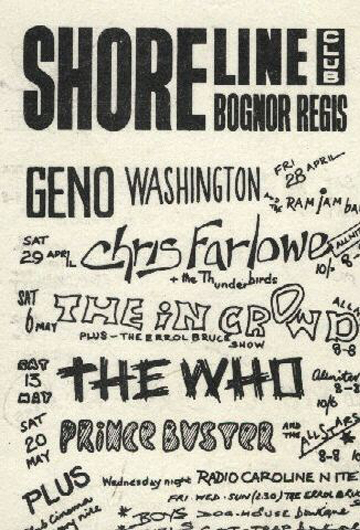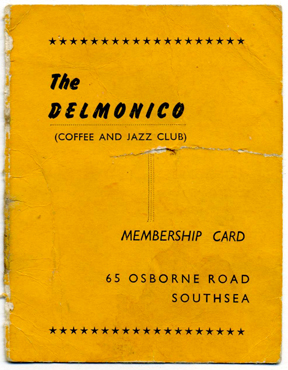On Saturday afternoons Verreccia's cafe and ice cream parlour in the Guildhall square was the place to be seen, it was a long narrow building with a line of tiny booths of high backed mahogany seats and marble tables that could just about squeeze six people round them. The scooters parked outside at the edge of the wide pavement always had crowds of mods round them and someone usually had a transistor radio borrowed from their mum tuned to 'Radio Caroline on 199,' the pirate radio station moored of Essex, which started transmitting in March 1964. When boredom set in it was time to go to Weston Hart’s record shop in Arundel Street or parade up Commercial Road to W.H. Smith's, where it was possible to fit three people into a listening booth and ask to hear the record of your choice. While listening it was usual to remove the posters in the booth to decorate bedroom walls or to enlarge the small holes in the sound proofing baffles. When it was obvious to the staff that we didn't have six and eightpence for a record, we were asked to leave. Maybe it was time to visit the clothes shops that stocked mod fashions, Smartwear, Squires or Shirt king in Charlotte Street. Scooterists usually wore parka's, desert boots, red socks and 'Levi's,' with a college scarf wrapped round the neck as protection from the wind. Only a few mods went to the local Colleges, so the others bought imitation college scarves from Charlotte Street and the wearer's were said to attend 'Shirt King College.' After having been shown the door from most of the shops it was back to Verrechias to discuss whose parents were away for the weekend so an instant party could be held, or which coffee bar or dance hall would be (un)lucky enough to have a crowd of noisy scooter riders descend upon it. The place in Southsea for mods to meet in was the Manhattan Coffee Lounge in Palmerston Road,

Photo: k. Preston.
The Manhattan was entered through a glass door set back from the pavement. Apart from the light that trickled through the large leaved plants in the windows, the illumination came from low wattage wall lights and a large brightly lit juke box that struggled to be heard above the frothing of the Espresso coffee machine near the counter. The nicotine tinged ceiling was covered in twisted cigarette foil 'egg-cups' that had been made with the foil from cigarette packets - the ‘egg cups’ had a cup at one end and a sticky pulp made by chewing the tissue paper peeled from the silver paper at the other end. The ‘egg cup’ was thrown upwards like a dart to stick on the ceiling.
The lounge had two distinct sets of customers, the Southsea ladies during the daytime and mods in the evening, young people drawn tthere because we all knew something exciting was happening. Some you maybe saw once but not again, names were not important it was being together that was, fighting the system ‘Anyway, Anyhow, Anywhere’. The mod girls in leather coats or blue nylon macs and Hush Puppy shoes had a choice when they entered the Manhattan. The scooter boys on one side dressed in ex-army, fur and badge covered khaki parka jackets, oily fingers clutching coke bottles as they lounged over tables littered with cigarette ends. On the other side sat the 'faces' in smart Italian suits and reefer jackets sipping coffee and talking about fashion and obscure American R 'n B groups. Some of them had scooters, usually Vespas.
Money was scarce so we tried to make one drink last all night, coke was the best choice because it was hard trying to look cool drinking coffee with a thick cold skin on top. Some mods worked in the Dockyard as apprentices, or were trainees in small businesses. It was handy to know people who worked in the Dockyard because they had access to equipment that could chrome bits of scooter. They could also get some work done on engine parts by skimming a few thousands of an inch off a cylinder head or put larger jets into carburetteurs as we tried to get more speed from our machines. Some scooter boys put Castrol R, a synthetic two-stroke oil used in racing engines, into their fuel to leave a distinctive smell in their wake.

Southsea Common 1965 scooter rally.
Mary, Steve, Stu, me (back right) and Rick who is sitting reading on my Lambretta, 914 DTP.
Outside the Manhattan there were often upwards of twenty scooters parked by Palmerston Road's infamous double-kerbed pavement. They used to say that you didn’t really come from Portsmouth until you had fallen into the Canoe Lake, falling up that double kerb counted as well! Most scooters were laden with chrome accessories, more spare wheels than could ever be needed, air horns, mirrors, spotlights, plastic tiger-skin seat covers, bullet hole transfers and ‘I’ve got a tiger in my tank’ tiger tails from the petrol station, fly shields with girlfriends names on and furry dangly things. Some had plastic stick-on tourist flags from Brighton, Southend, Clacton, Margate, or where the last 'friendly' with the leather clad opposition had been. Some scooters were stripped down to bare frames holding just the minimum of parts to keep them running and legal. Some 'Christmas trees' as the locals called them, sported tank aerials twelve feet high fixed to their rear carriers, bought from Ben Grubb's, an ex-government store in Commercial road, or Weltons in Fratton Road. The length of the aerials made the scooters very unstable when cornering. Some mods mounted cans of paint spray on the leg shields of their scooters. When encountering aggressive car drivers they would overtake smiling and the motorist would usually wave back with two fingers, he would not see the fine spray of paint applied to the side of his car until he stopped and got out, because as they overtook they would press the nozzle. Spray cans at different heights left artistic stripes of coloured paint horizontally along vehicles as they passed. Sunday afternoons we met ouside the Manhattan for runs out of the City to Brighton or the Shoreline Club at Bognor on a Sunday afternoon. The Shoreline was a ‘teenage hotel,’ a big old hotel converted to a club with accommodation especially aimed at teenagers who wanted some time away from parents and police to ‘do their own thing, not surprisingly, the place was shut down amidst tales of under-age sex, drugs and other ‘goings-on.’

Apart from Mojo and Dave Allen, I rarely saw anyone else on the scene from my old school, as Dave noted in his 1998 autobiography ‘Almost - Forty Years of Southsea Rock and Pompey Blues’, the number of ex-grammar school boys who were involved with the Portsmouth mods were few indeed,
“….most Pompey Mods knew each other from schools like the Technical High, the state Grammar Schools and the many secondary moderns around the city there were only a handful of people at Portsmouth Grammar School who were involved in the mod scene. A couple were older than me, Glyn and Nigel Grundy, sixties photographer, artist and now fellow university lecturer. Otherwise there was Martin, Brian and me and that was pretty well it in the early days”.

We also went to the Delmonico coffee lounge in Osborne Road, it was run by Charles, who looked and moved like the butler in Thunderbirds. There was a cellar club below stairs called the Hideaway but it wasn’t popular. The Moody Blues went into the Delmonico when they played at Kimbell’s and a girl followed them back and wrote ‘The moody’s walked here’ in chalk all the way back to the ballroom.
